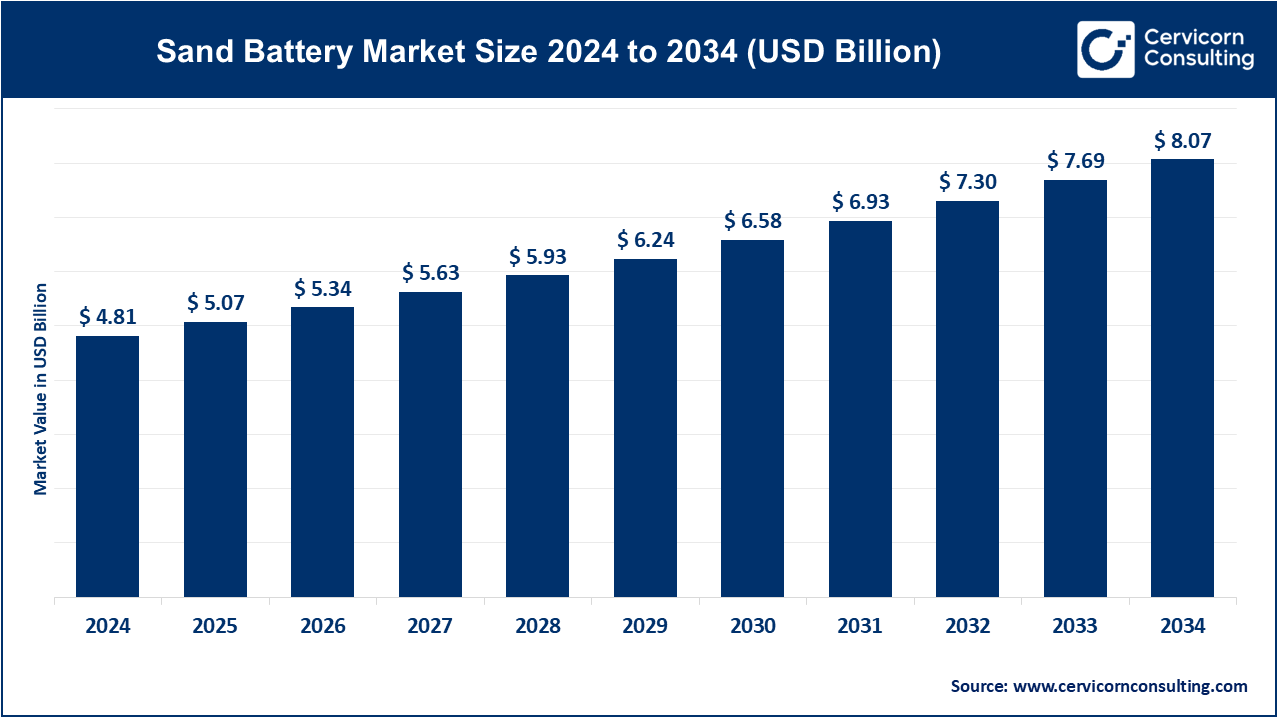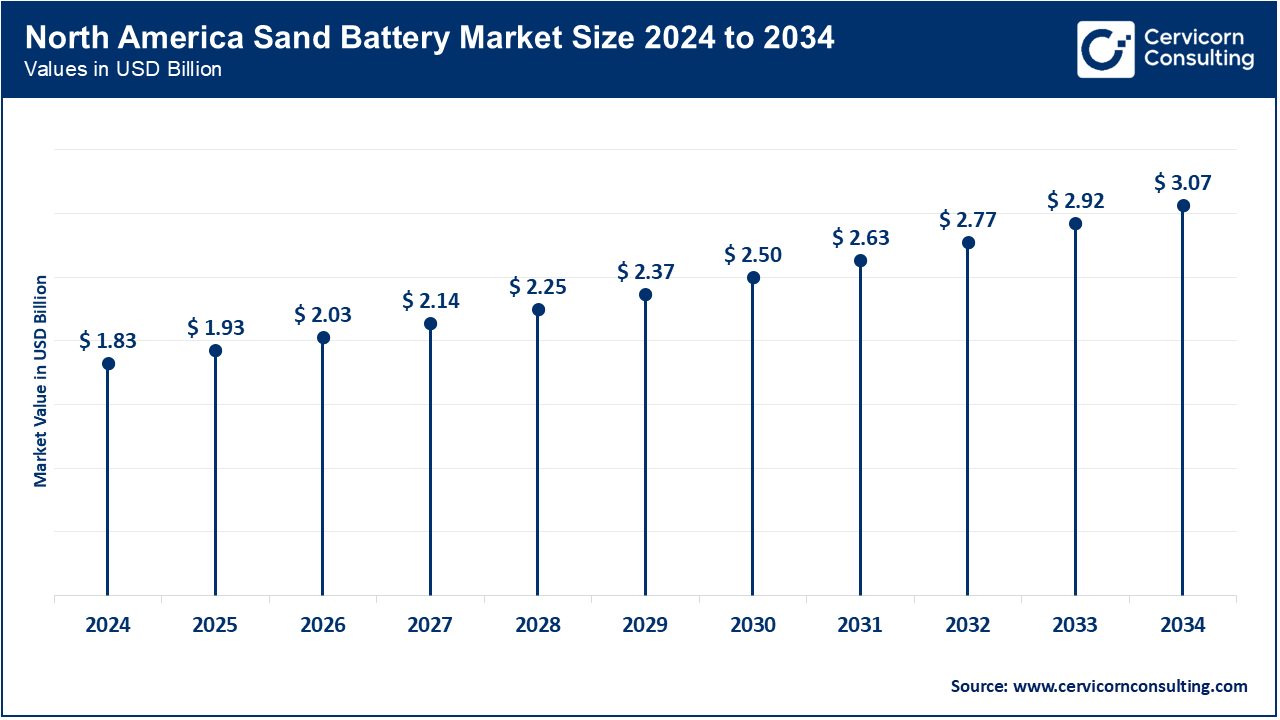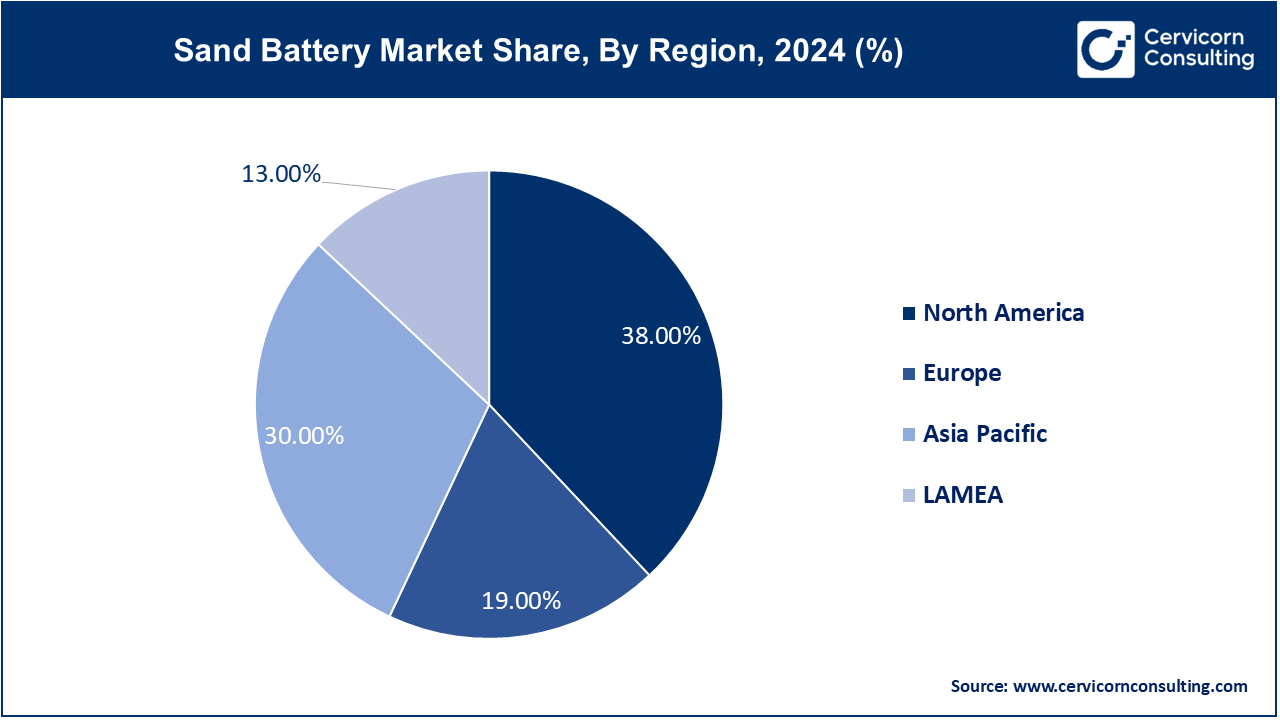The global sand battery market size was valued at USD 4.81 billion in 2024 and is expected to be worth around USD 8.07 billion by 2034, expanding at a compound annual growth rate (CAGR) of 5.31% over the forecast period 2025 to 2034.
The demand for efficient and sustainable energy storage is driving the growth of sand batteries market. Governments worldwide are investing in renewable energy, creating opportunities for thermal energy storage solutions. The increasing adoption of grid-scale energy storage and advancements in high-temperature heat storage are boosting market demand. Europe and North America are at the forefront, while Asia-Pacific is expected to see rapid adoption due to growing industrial needs. Industries such as district heating, manufacturing, and renewable power storage are integrating sand batteries due to their cost-effectiveness and ability to store energy for months. As the focus on decarbonization and energy security increases, sand battery technology is expected to see widespread adoption in both developed and emerging economies.

Key trends driving the market include a rise in demand for the integration of renewable energy, push for eco-friendly and sustainable energy storage solutions, and acceptance of advanced thermal storage technologies. There is also an increasing focus on reducing energy waste, enhancing storage capacity, and increasing the reliabilities of energy supply in off-grid and remote areas. Government initiatives for the adoption of renewable energy and sustainable practices, along with regulatory support, also form major factors that drive growth in the sand battery market.
What is a Sand Battery?
A sand battery is an innovative energy storage system that uses sand or sand-like materials to store thermal energy. It works by heating sand to high temperatures (over 500°C) using renewable energy sources like solar or wind power. The sand retains heat for long periods, allowing stored energy to be used later for district heating, industrial processes, or power generation. This technology is particularly useful for overcoming the intermittency of renewable energy by storing surplus electricity when supply is high and releasing heat when demand increases. Sand batteries have high energy density, long storage durations, and low maintenance costs. Unlike lithium-ion batteries, they do not degrade over time and are environmentally friendly since sand is abundant and non-toxic.
Key Insights
Report Scope
| Area of Focus | Details |
| Market Size in 2025 | USD 5.07 Billion |
| Projected Market Size in 2034 | USD 8.07 Billion |
| Growth Rate (2025 to 2034) | 5.31% |
| Leading Region | North America |
| Fastest Growing Region | Asia-Pacific |
| Segments Covered | Type, Service, Technology, Storage Capacity, End User, Region |
| Key Companies | Polar Night Energy, Sila Nanotechnologies Inc., BrightSource Energy, SolarReserve, EnergyNest, Stornetic, Azelio, Caloric GmbH, Highview Power, Vatajankoski, Malta Inc., Enel Green Power, Abengoa, Siemens Gamesa, TSK Flagsol Engineering |
Increased Funding and Investment
Rising Energy Costs
Technological Limitations
Supply Chain Challenges
Emerging Technologies
Growing Awareness and Education
Skilled Labor Shortages
Regulatory Compliance
The North America sand battery market size was valued at USD 1.83 billion in 2024 and is projected to hit around USD 3.07 billion by 2034. North America is leading the market due to its advanced renewable energy sector and strong focus on sustainable energy storage solutions. The U.S. and Canada are at the forefront of adopting innovative energy storage technologies, including sand batteries, to enhance grid stability and support the growing integration of renewable energy sources like solar and wind. Significant investments in renewable energy projects, government incentives for green technologies, and a robust regulatory framework drive market growth in this region. Additionally, the region's emphasis on energy independence and reducing carbon emissions contributes to the increasing adoption of sand battery systems.

The Europe sand battery market size was estimated at USD 0.91 billion in 2024 and is predicted to surpass around USD 1.53 billion by 2034. Europe market is driven by the region's commitment to sustainability and its leadership in renewable energy adoption. Countries like Germany, Finland, and the UK are pioneers in implementing advanced energy storage solutions, including sand batteries, to support their ambitious climate goals. The European Union's stringent regulations on carbon emissions, coupled with generous subsidies and incentives for renewable energy projects, are key factors fueling market growth. Moreover, the region's focus on energy security and the need to reduce reliance on fossil fuels further boost the adoption of sand battery technology across various sectors.
The Asia-Pacific and battery market size was accounted for USD 1.44 billion in 2024 and is projected to record USD 2.42 billion by 2034. The Asia-Pacific market is driven by the increasing demand for efficient energy storage solutions to support the region's expanding renewable energy capacity. Countries such as China, Japan, and India are leading the charge in deploying sand batteries to manage the integration of solar and wind energy into their grids. Government initiatives promoting renewable energy adoption, coupled with significant investments in smart grid infrastructure, are propelling market growth. Additionally, the region's ongoing urbanization and industrialization efforts create a strong demand for reliable and sustainable energy storage technologies.

LAMEA Sand Battery Market is Expanding
The LAMEA sand battery market size was accounted for USD 0.63 billion in 2024 and is anticipated to hit around USD 1.05 billion by 2034. LAMEA is expanding as the region increasingly focuses on sustainable energy solutions and improving energy infrastructure. In Latin America, the adoption of sand batteries is gaining traction as countries seek to enhance their renewable energy storage capabilities. The Middle East, with its vast solar energy potential, is also investing in sand battery technology to store and manage energy efficiently. Although Africa faces challenges such as limited resources and infrastructure, international partnerships and funding initiatives are helping to drive the adoption of innovative energy storage solutions, including sand batteries, across the continent. These efforts are crucial for supporting the region's energy needs and promoting sustainable development.
Thermal Sand Batteries: Thermal sand batteries are designed to store heat in sand, which can later be converted into electricity. These batteries are particularly effective for large-scale energy storage applications and are increasingly being used in renewable energy integration projects due to their high thermal capacity and cost-effectiveness. Their ability to store and release energy efficiently makes them ideal for balancing energy supply in systems relying heavily on intermittent renewable sources like solar and wind.
Electric Sand Batteries: Electric sand batteries store electrical energy by converting it into heat, which is then stored in sand and converted back into electricity when needed. This type of battery is especially useful for grid storage applications, where it can support energy supply during peak demand periods. By leveraging the thermal properties of sand, these batteries provide a reliable and efficient way to manage electricity supply and demand on a large scale
Installation Services: Installation services for sand batteries include the planning, setup, and commissioning of these energy storage systems. Companies specializing in these services ensure that sand battery systems are properly installed to optimize their performance and safety. This involves detailed planning and execution to integrate the battery systems seamlessly with existing energy infrastructure, ensuring long-term operational efficiency.
Maintenance and Support Services: Regular maintenance and support services are crucial for ensuring the efficient operation of sand battery systems over their lifespan. These services typically include routine inspections, troubleshooting, and system upgrades, which help maintain the longevity and reliability of the batteries. By providing ongoing support, these services ensure that the sand battery systems continue to perform at their best, reducing the risk of unexpected downtime.
Consulting Services: Consulting services provide expert guidance on the design, implementation, and optimization of sand battery projects. These services help clients choose the most suitable type and configuration of sand batteries based on their specific energy storage needs. Additionally, consultants ensure that the projects comply with relevant regulatory standards, providing a comprehensive solution that meets both technical and legal requirements
Heat Transfer Technology: Heat transfer technology in sand batteries involves efficiently transferring thermal energy to and from the sand medium. Advancements in this technology have significantly improved the efficiency and speed of energy storage and retrieval, making sand batteries more effective for large-scale energy storage applications. This technology is key to maximizing the performance of sand batteries in renewable energy systems.
Energy Conversion Technology: Energy conversion technology focuses on converting the stored thermal energy in sand back into electricity. Innovations in this area have enhanced the efficiency of the conversion process, ensuring more reliable and consistent energy delivery. This technology is crucial for making sand batteries a viable option for grid-scale energy storage and other demanding applications.
Thermal Management Systems: Thermal management systems are essential for maintaining optimal operating temperatures within sand batteries. These systems prevent overheating and improve the overall efficiency and safety of the energy storage process. By ensuring that the temperature within the battery remains stable, thermal management systems help extend the lifespan of the battery and enhance its performance
Residential: Residential users of sand batteries benefit from these systems by gaining access to reliable backup power and improved energy efficiency. Sand batteries can store excess energy generated from solar panels and release it during times of high demand or power outages, providing a sustainable and cost-effective solution for homeowners looking to maximize their use of renewable energy.
Commercial: Commercial establishments utilize sand batteries to manage energy consumption more effectively and reduce electricity costs. These batteries support load shifting and peak shaving, enabling businesses to optimize their energy use and reduce their dependency on the grid. By integrating sand batteries, commercial users can enhance their energy resilience and contribute to sustainability goals.
Industrial: Industrial users deploy sand batteries for large-scale energy storage needs, such as stabilizing power supply and integrating renewable energy sources into their operations. The high capacity and reliability of sand batteries make them well-suited for energy-intensive applications in industries that require consistent and stable power supply, helping to reduce operational costs and improve energy efficiency.
Utility: Utility companies use sand batteries to enhance grid stability and support the integration of renewable energy sources. These batteries offer large-scale energy storage solutions that help balance supply and demand, ensuring a stable and reliable power grid. By deploying sand batteries, utilities can better manage fluctuations in energy production and consumption, particularly in systems with a high penetration of renewable energy
Among the emerging players in the sand battery industry, Polar Night Energy is pioneering innovative sand-based energy storage solutions, offering sustainable alternatives for large-scale energy storage. Sila Nanotechnologies Inc. is making strides by enhancing the energy density and efficiency of sand-based batteries, positioning itself as a key player in the renewable energy sector.
Established companies like EnergyNest are leading the market with their advanced thermal storage systems, designed to integrate seamlessly with renewable energy sources. Highview Power leverages cutting-edge cryogenic technology in conjunction with sand-based storage, providing robust solutions for grid-scale energy management. Additionally, collaborations and technological advancements by companies like Azelio and Siemens Gamesa highlight their commitment to driving innovation and growth in the rapidly evolving sand battery industry.
CEO Statements
Mikko Paajanen, CEO of Loviisan Lämpö:
"Loviisan Lämpö is moving towards more environmentally friendly energy production. With the Sand Battery, we can significantly reduce energy produced by combustion and completely eliminate the use of oil."
Heikki Vauhkonen, CEO of Tulikivi:
"Collaborating with Polar Night Energy is an interesting venture into a new business, leveraging the traditional strengths of soapstone, such as excellent heat conduction and retention properties. This collaboration supports Tulikivi's goals of maximizing the utilization of raw materials."
Tommi Eronen, CEO of Polar Night Energy:
"We need predictive modeling to answer as many questions as possible before we commit to assembling all this equipment-and all this sand!"
Market Segmentation
By Type
By Service
By Technology
By Storage Capacity
By End-Users
By Region
Chapter 1 Market Introduction and Overview
1.1 Market Definition and Scope
1.1.1 Overview of Sand Battery
1.1.2 Scope of the Study
1.1.3 Research Timeframe
1.2 Research Methodology and Approach
1.2.1 Methodology Overview
1.2.2 Data Sources and Validation
1.2.3 Key Assumptions and Limitations
Chapter 2 Executive Summary
2.1 Market Highlights and Snapshot
2.2 Key Insights by Segments
2.2.1 By Type Overview
2.2.2 By Service Overview
2.2.3 By Technology Overview
2.2.4 By Storage Capacity Overview
2.2.5 By End-Users Overview
2.3 Competitive Overview
Chapter 3 Global Impact Analysis
3.1 COVID 19 Impact on Sand Battery Market
3.1.1 COVID-19 Landscape: Pre and Post COVID Analysis
3.1.2 COVID 19 Impact: Global Major Government Policy
3.1.3 Market Trends and Opportunities in the COVID-19 Landscape
3.2 Russia-Ukraine Conflict: Global Market Implications
3.3 Regulatory and Policy Changes Impacting Global Markets
Chapter 4 Market Dynamics and Trends
4.1 Market Dynamics
4.1.1 Market Drivers
4.1.1.1 Increased Funding and Investment
4.1.1.2 Rising Energy Costs
4.1.2 Market Restraints
4.1.2.1 Technological Limitations
4.1.2.2 Supply Chain Challenges
4.1.3 Market Opportunity
4.1.3.1 Emerging Technologies
4.1.3.2 Growing Awareness and Education
4.1.4 Market Challenges
4.1.4.1 Skilled Labor Shortages
4.1.4.2 Regulatory Compliance
4.2 Market Trends
Chapter 5 Premium Insights and Analysis
5.1 Global Sand Battery Market Dynamics, Impact Analysis
5.2 Porter’s Five Forces Analysis
5.2.1 Bargaining Power of Suppliers
5.2.2 Bargaining Power of Buyers
5.2.3 Threat of Substitute Products
5.2.4 Rivalry among Existing Firms
5.2.5 Threat of New Entrants
5.3 PESTEL Analysis
5.4 Value Chain Analysis
5.5 Product Pricing Analysis
5.6 Vendor Landscape
5.6.1 List of Buyers
5.6.2 List of Suppliers
Chapter 6 Sand Battery Market, By Type
6.1 Global Sand Battery Market Snapshot, By Type
6.1.1 Market Revenue (($Billion) and Growth Rate (%), 2022-2034
6.1.1.1 Thermal Sand Batteries
6.1.1.2 Electric Sand Batteries
Chapter 7 Sand Battery Market, By Service
7.1 Global Sand Battery Market Snapshot, By Service
7.1.1 Market Revenue (($Billion) and Growth Rate (%), 2022-2034
7.1.1.1 Installation Services
7.1.1.2 Maintenance and Support Services
7.1.1.3 Consulting Services
Chapter 8 Sand Battery Market, By Technology
8.1 Global Sand Battery Market Snapshot, By Technology
8.1.1 Market Revenue (($Billion) and Growth Rate (%), 2022-2034
8.1.1.1 Heat Transfer Technology
8.1.1.2 Energy Conversion Technology
8.1.1.3 Thermal Management Systems
Chapter 9 Sand Battery Market, By Storage Capacity
9.1 Global Sand Battery Market Snapshot, By Storage Capacity
9.1.1 Market Revenue (($Billion) and Growth Rate (%), 2022-2034
9.1.1.1 Low Capacity (Up to 10 MWh)
9.1.1.2 Medium Capacity (10-50 MWh)
9.1.1.3 High Capacity (Above 50 MWh)
Chapter 10 Sand Battery Market, By End-Users
10.1 Global Sand Battery Market Snapshot, By End-Users
10.1.1 Market Revenue (($Billion) and Growth Rate (%), 2022-2034
10.1.1.1 Residential
10.1.1.2 Commercial
10.1.1.3 Industrial
10.1.1.4 Utility
Chapter 11 Sand Battery Market, By Region
11.1 Overview
11.2 Sand Battery Market Revenue Share, By Region 2024 (%)
11.3 Global Sand Battery Market, By Region
11.3.1 Market Size and Forecast
11.4 North America
11.4.1 North America Sand Battery Market Revenue, 2022-2034 ($Billion)
11.4.2 Market Size and Forecast
11.4.3 North America Sand Battery Market, By Country
11.4.4 U.S.
11.4.4.1 U.S. Sand Battery Market Revenue, 2022-2034 ($Billion)
11.4.4.2 Market Size and Forecast
11.4.4.3 U.S. Market Segmental Analysis
11.4.5 Canada
11.4.5.1 Canada Sand Battery Market Revenue, 2022-2034 ($Billion)
11.4.5.2 Market Size and Forecast
11.4.5.3 Canada Market Segmental Analysis
11.4.6 Mexico
11.4.6.1 Mexico Sand Battery Market Revenue, 2022-2034 ($Billion)
11.4.6.2 Market Size and Forecast
11.4.6.3 Mexico Market Segmental Analysis
11.5 Europe
11.5.1 Europe Sand Battery Market Revenue, 2022-2034 ($Billion)
11.5.2 Market Size and Forecast
11.5.3 Europe Sand Battery Market, By Country
11.5.4 UK
11.5.4.1 UK Sand Battery Market Revenue, 2022-2034 ($Billion)
11.5.4.2 Market Size and Forecast
11.5.4.3 UK Market Segmental Analysis
11.5.5 France
11.5.5.1 France Sand Battery Market Revenue, 2022-2034 ($Billion)
11.5.5.2 Market Size and Forecast
11.5.5.3 France Market Segmental Analysis
11.5.6 Germany
11.5.6.1 Germany Sand Battery Market Revenue, 2022-2034 ($Billion)
11.5.6.2 Market Size and Forecast
11.5.6.3 Germany Market Segmental Analysis
11.5.7 Rest of Europe
11.5.7.1 Rest of Europe Sand Battery Market Revenue, 2022-2034 ($Billion)
11.5.7.2 Market Size and Forecast
11.5.7.3 Rest of Europe Market Segmental Analysis
11.6 Asia Pacific
11.6.1 Asia Pacific Sand Battery Market Revenue, 2022-2034 ($Billion)
11.6.2 Market Size and Forecast
11.6.3 Asia Pacific Sand Battery Market, By Country
11.6.4 China
11.6.4.1 China Sand Battery Market Revenue, 2022-2034 ($Billion)
11.6.4.2 Market Size and Forecast
11.6.4.3 China Market Segmental Analysis
11.6.5 Japan
11.6.5.1 Japan Sand Battery Market Revenue, 2022-2034 ($Billion)
11.6.5.2 Market Size and Forecast
11.6.5.3 Japan Market Segmental Analysis
11.6.6 India
11.6.6.1 India Sand Battery Market Revenue, 2022-2034 ($Billion)
11.6.6.2 Market Size and Forecast
11.6.6.3 India Market Segmental Analysis
11.6.7 Australia
11.6.7.1 Australia Sand Battery Market Revenue, 2022-2034 ($Billion)
11.6.7.2 Market Size and Forecast
11.6.7.3 Australia Market Segmental Analysis
11.6.8 Rest of Asia Pacific
11.6.8.1 Rest of Asia Pacific Sand Battery Market Revenue, 2022-2034 ($Billion)
11.6.8.2 Market Size and Forecast
11.6.8.3 Rest of Asia Pacific Market Segmental Analysis
11.7 LAMEA
11.7.1 LAMEA Sand Battery Market Revenue, 2022-2034 ($Billion)
11.7.2 Market Size and Forecast
11.7.3 LAMEA Sand Battery Market, By Country
11.7.4 GCC
11.7.4.1 GCC Sand Battery Market Revenue, 2022-2034 ($Billion)
11.7.4.2 Market Size and Forecast
11.7.4.3 GCC Market Segmental Analysis
11.7.5 Africa
11.7.5.1 Africa Sand Battery Market Revenue, 2022-2034 ($Billion)
11.7.5.2 Market Size and Forecast
11.7.5.3 Africa Market Segmental Analysis
11.7.6 Brazil
11.7.6.1 Brazil Sand Battery Market Revenue, 2022-2034 ($Billion)
11.7.6.2 Market Size and Forecast
11.7.6.3 Brazil Market Segmental Analysis
11.7.7 Rest of LAMEA
11.7.7.1 Rest of LAMEA Sand Battery Market Revenue, 2022-2034 ($Billion)
11.7.7.2 Market Size and Forecast
11.7.7.3 Rest of LAMEA Market Segmental Analysis
Chapter 12 Competitive Landscape
12.1 Competitor Strategic Analysis
12.1.1 Top Player Positioning/Market Share Analysis
12.1.2 Top Winning Strategies, By Company, 2022-2024
12.1.3 Competitive Analysis By Revenue, 2022-2024
12.2 Recent Developments by the Market Contributors (2024)
Chapter 13 Company Profiles
13.1 Polar Night Energy
13.1.1 Company Snapshot
13.1.2 Company and Business Overview
13.1.3 Financial KPIs
13.1.4 Product/Service Portfolio
13.1.5 Strategic Growth
13.1.6 Global Footprints
13.1.7 Recent Development
13.1.8 SWOT Analysis
13.2 Sila Nanotechnologies Inc.
13.3 BrightSource Energy
13.4 SolarReserve
13.5 EnergyNest
13.6 Stornetic
13.7 Azelio
13.8 Caloric GmbH
13.9 Highview Power
13.10 Vatajankoski